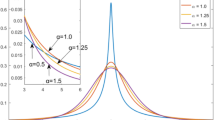Abstract
Sensor arrays are widely used to locate the radiating sources by estimating the direction of arrival (DOA) of their incident signals. Among the most well-known methods employed for DOA estimation is the multiple signal classification (MUSIC). MUSIC provides outstanding performance in estimating DOAs in good propagation environments; however, it fails to estimate the DOAs in severe environments like low signal-to-noise ratio, small number of snapshots, when the incident waves are coming from close angles or when the sources are highly correlated. In this paper, we propose a new approach for DOA estimation with super-resolution capabilities and high accuracy even in the severe environments. The proposed approach is based on computing the second-order differential of invariant noise MUSIC (SODIN-MUSIC) spectrum. SODIN-MUSIC benefits from extracting useful information provided by the second-order differential of MUSIC spectrum and also utilizing the invariance property of noise subspace with respect to changing the power of the emitted signals. In this paper, the proposed SODIN-MUSIC method is developed to estimate both one-dimensional and two-dimensional DOA with any arbitrary array configurations. The simulation results show that SODIN-MUSIC yields superior performance in all distinct environments if compared to both conventional MUSIC and other newly developed MUSIC-based methods.












Similar content being viewed by others
References
C.A. Balanis, P. Ioannides, Introduction to Smart Antennas (Morgan & Claypool Publishers, San Rafael, 2007)
A.J. Barabell, in Improving the resolution performance of eigenstructure based direction-finding algorithms. Proceedings ICASSP’83, Boston, USA (April 1983), p. 336–339
G. Bienvenu, N.L. Owsley, High Resolution Passive Array Processing: An Overview of Principles, in High Resolution Methods in Underwater Acoustics, ed. by M. Bouvet, G. Bienvenu. (Springer, Berlin, 1991), pp. 7–28
K.M. Buckley, X.L. Xu, Spatial spectrum estimation in a location sector. IEEE Trans. Acoust. Speech Signal Process. 38, 1842–1852 (1990)
J.P. Burg.: Maximum Entropy Spectral Analysis. Paper Presented at 37th Annual Meeting. (Society of Exploration in Geophysics, Oklahoma City, 1967)
J. Capon, High resolution frequency wave number spectrum analysis. IEEE Proc. 57, 1408–1418 (1969)
J. Foutz, A. Spanias, M.K. Banavar, Narrowband Direction of Arrival Estimation for Antenna Arrays (Morgan & Claypool, San Rafael, 2008)
B. Friedlander, in Wireless Direction—Finding Fundamentals. Appears in Chapter 1 in Classical and Modern Direction of Arrival Estimation (Elsevier, Amsterdam, 2009), p. 1–47
L.C. Godara, Smart Antennas (CRC Press, Boca Raton, 2004)
S. Haykin, Array Signal Processing (Prentice Hall, Upper Saddle River, 1985)
K. Ichige, Y. Ishikawa, H. Arai, in Accurate Direction-of-Arrival Estimation Using Second-Order Differential of MUSIC Spectrum Proceedings of International Symposium on Intelligent Signal Processing and Communication Systems, no. WPM1-1-2 (2006)
K. Ichige, Y. Ishikawa, H. Arai, in High Resolution 2-D DOA Estimation Using Second-Order Partial-Differential of MUSIC Spectrum IEEE International Symposium on Circuits and Systems, Seattle, WA. ISCAS (2008)
D.H. Johnson, The application of spectral estimation methods to bearing estimation problems. IEEE Proc. 70, 1018–1028 (1982)
M. Kaveh, A.J. Barabell, in The Statistical Performance of the MUSIC and the Minimum-Norm Algorithms in Resolving Plane Waves in N. IEEE Transaction Acoustics, Speech, Signal Processing, vol.ASSP-34 (1986) no. (2), p. 331–341
H. Krim, M. Viberg, Two decades of array signal processing research. IEEE Signal Process. Mag. 13, 67–94 (1996)
R. Kumaresan, D.W. Tufts, Estimating of the angles of arrival of multiple plane waves. IEEE Trans. Aerosp. Electron. Syst. 19, 134–139 (1983)
M. Kwakkernaat, Y. De Jong, M. Herben, in Mobile High-Resolution Direction Finding of Multipath Radio Waves in Azimuth and Elevation, The First Annual IEEE Benelux/dsp Valley Signal Processing Symposium (SPS-DARTS), Antwerp, Belgium (2005)
M.-H. Li, Y.-L. Lu, in Improving the Performance of GA-ML DOA Estimator with Resampling Scheme. Signal Processing (Elsevier, Amsterdam, 2004), p. 1813–1822
D.-H. Liu, X. Wu, B.-Y. Wen, F. Cheng, Application of ESPRIT in broad beam HF ground wave radar sea surface current mapping. Wuhan Univ. J. Nat. Sci. 9(2), 209–214 (2004)
A. Olfat, S.N. Esfahani, A new signal subspace processing for DOA estimation. Sig. Process. 84, 721–728 (2004)
P. Palanisamy, N. Raghu, in A New L-shape 2-Dimensional Angle of Arrival Estimation Based on Propagator Method. Proceeding of IEEE TENCON (2008), p. 1–6
V.F. Pisarenko, The retrieval of harmonics from a covariance function. Geophys. J. Int. 33, 347–366 (1973)
T.S. Rappaport, J.C. Liberti, Smart Antennas for Wireless Communications: IS-95 and Third Generation CDMA Applications (Prentice Hall, Upper Saddle River, 1999)
R. Roy, T. Kailath, ESPRIT-estimation of signal parameters via rotational invariance techniques. IEEE Trans. Acoust. Speech Signal Process. 37(7), 984–995 (1999)
M. Rubsamen, A. Gershman, in Search-Free DOA Estimation Algorithms for Non-uniform Sensor Arrays, Appears in Chapter 5 of “Classical and Modern Direction-of-Arrival Estimation (Academic Press, Cambridge, 2009), p. 161–183
R.O. Schmidt, in IEEE Transaction Antennas Propagation AP-34(3). Multiple Emitter Location and Signal Parameter Estimation (1986), p. 276–280
P. Stoica, B. Gershman, Maximum-likelihood DOA estimation by data-supported grid search. IEEE Signal Process. Lett. 6(10), 273–275 (1999)
H.L. Van Trees, Optimum Array Processing, Part IV of Detection, Estimation and Modulation Theory (Wiley, New York, 2002)
B.D. VanVeen, K.M. Buckley, Beamforming: a versatile approach to spatial filtering. Signal Process. Mag. 5, 4–24 (1988)
Q.T. Zhang, Probability of resolution of the MUSIC algorithm. IEEE Trans. Signal Process. 43, 978–987 (1995)
Author information
Authors and Affiliations
Corresponding author
Rights and permissions
About this article
Cite this article
Massoud, A., Noureldin, A. DOA Estimation Using Second-Order Differential of Invariant Noise MUSIC (SODIN-MUSIC). Circuits Syst Signal Process 36, 703–720 (2017). https://doi.org/10.1007/s00034-016-0327-2
Received:
Revised:
Accepted:
Published:
Issue Date:
DOI: https://doi.org/10.1007/s00034-016-0327-2




